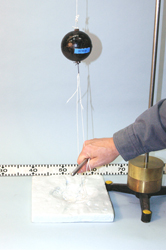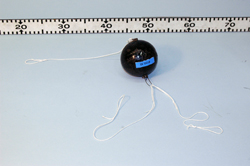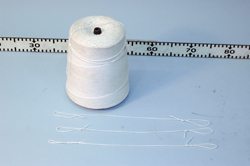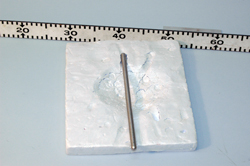Inertia Ball, 1F20.10
Topic and Concept:
Newton's First Law, 1F20. Inertia of Rest
pira200 Listed
Location:
Cabinet: Mechanic (ME)
Bay: (A7)
Shelf: #5
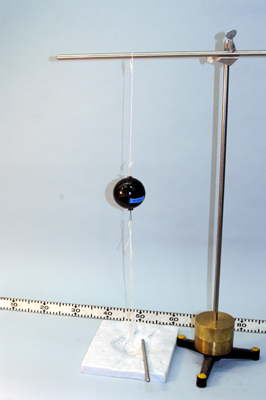
Abstract:
A heavy ball is suspended by a piece of string with two pieces of string hanging off the bottom, all pieces being identical. One bottom string is yanked with a quick, hard jerk resulting in it breaking while the other is pulled slowly resulting in the top string breaking.
Equipment |
Location |
ID Number |
|
|
|
1.8 kg (4 lb) Ball |
ME, Bay A7, Shelf #5 |
|
0.038" 15# test, unpolished cotton Twine |
ME, Bay A7, Shelf #5 |
|
Styrofoam Square |
ME, Bay A7, Shelf #5 |
|
Short Metal Rod |
Rod and Clamp Cabinet |
|
3/4" Support Rod w/Table Clamp |
Rod and Clamp Cabinet |
|
Important Setup Notes:
Making the sections of string with looped ends takes time and may need practice.
Be sure to use a Styrofoam square or something similar beneath the setup to catch the ball. This is to prevent damage to the bench top or the ball.
DO NOT use the 1/2" support stand as pictured! Be sure to use a table-mounted 3/4" support rod.
Setup and Procedure:
- Using a table clamp, attach a 3/4" support rod to the lecture bench.
- Place the Styrofoam square on the table so that it will lie beneath the suspended ball.
- Make 3 identical sections of string with looped ends.
- Making use of the loops, attach one string to one end of the ball and the other two to the other end.
- Use the single string to suspend the ball from the support rod.
- Use the loop of one of the two strings to attach it to the short metal rod.
- Pull downward on the short rod with a quick, hard jerk. This will result in this pulled string breaking.
- Use the loop of one of the other string to attach it to the short metal rod.
- Slowly pull downward on the short rod. This will result in the top string breaking.
Cautions, Warnings, or Safety Concerns:
- Take care in handling the ball. If dropped on a foot or on the floor, significant damage could be done.
Discussion:
The ball is relatively heavy and so has a relatively large inertia of rest. Ask the audience which string they think will break, a trick question since it depends on how the sting is pulled. If one of the bottom strings is pulled with a quick, hard jerk, it will break since the tensile strength of the string is exceeded by the relatively large inertia of the suspended ball. If the other bottom string is pulled down gradually, then the top string will break because of its tensile strength being overcome by the increasing effective weight of the ball.
|
|
|
|
Videos:
References:
- N/A
